Bret Dixon Insurance News
Our newsletters are intended to keep you up to date on
pertinent industry news and offer more in-depth insight into various
types of coverage and endorsements. We publish our newsletters
at least once each quarter. We hope you enjoy it.
Thank you for your patronage!
|
|
|
Brace for Rising Homeowners Prices
The $65
billion homeowner product industry is approaching a financial
 crossroads
and carriers will need to make changes. Industry-wide loss
information indicates that over the last 30 years, the return on the
homeowners product line has been less than the cost of capital.
Over the last 25 years, the industry's "combined ratio" has
been 112%. That means for every $1 collected in premium,
carriers have paid out $1.12. Extrapolate that out over $65
billion and you'll find yourself staring at some ugly math. crossroads
and carriers will need to make changes. Industry-wide loss
information indicates that over the last 30 years, the return on the
homeowners product line has been less than the cost of capital.
Over the last 25 years, the industry's "combined ratio" has
been 112%. That means for every $1 collected in premium,
carriers have paid out $1.12. Extrapolate that out over $65
billion and you'll find yourself staring at some ugly math.
This is the
crisis that homeowners insurers are now faced with, and it's only
been worsened by a record year for destructive weather and natural
disasters in 2011.
The market for
homeowners is changing, and it's going to
continue to change. Consumers can probably
get some idea of this just by turning on the evening news.
Catastrophes have played a role - both in the U.S and around the
globe - but they're not alone. A struggling economy has played
a role as well.
For a segment
of the insurance industry that was already losing money, it certainly
didn't help that:
- The first half of 2011 saw 43 major
thunderstorms, which released 1600 tornadoes across the U.S.,
with 226 verified tornadoes striking in one day (4/26/11)
- Thunderstorm losses reached a record 23.6
billion in financial losses
- Through just the first six months, 2011
was already the highest loss year on record globally
- The northeastern U.S. experienced a
tornado, earthquake, hurricane and a significant pre-Halloween
snowstorm all in the same year.
- Through just October 3rd, the number of
federal disaster declarations set a new record in 2011, with 90
And economic
pressures contributed to a crushing year as well, through:
- Decline in investment yield, putting
greater pressure on underwriting income
- Loss cost increases - with a tougher
economy comes an increase in frequency of smaller losses
- With fewer new homes being built,
construction costs have increased due to economic pressures and
recession.
- Increased oil prices tend to drive up the
costs of asphalt shingles, which are used by about 66% of U.S.
homes.
- Limited exposure growth, due to a troubled
housing market and recession
So brace
yourselves for increased premiums and other changes on your
homeowners policies. We've written before about tightening of
Replacement Cost requirements and closer monitoring of loss
history data. Now, some companies are faced with tough
decisions like increasing rates, tightening underwriting requirements
and eligibility, enacting coverage changes to cut coverage or even
pulling out of the homeowners market - in totality, or just segments.
As an agent,
there are a few things we can do to mitigate increases. For
one, conducting a review of your homeowners - running a current
replacement cost estimator, looking for any potential discounts that
may be available. We can try and bundle or package your other
policies to maximize multi-policy discounts by putting your auto,
personal articles, boat or umbrella with the same carrier as your
home. We can talk about increasing your deductible. Those
things can help, but unfortunately, there's no getting around rate
increases. They're coming; It's 2012, not 2002. Times are
different, and as we're seeing, homeowners rates are different too.
|
|
Food Handlers Guidelines in
the Prevention of Foodborne Illnesses
Every once in awhile we'll see a food contamination
claim.
 They're
pretty rare, but when they do happen, they tend to be costly, as tens
or possibly even hundreds of patrons could be affected.
Moreover, not only are those patrons made ill, but word of
mouth will surely get around about the incident, possibly turning
would-be patrons off and cutting down the number of customers
coming in your door. Furthermore, your business must follow
strict Health Department guidelines before being allowed to re-open,
which could include disposal of all or some foods, thorough cleaning
and sanitizing of your kitchen and possibly even having employees
vaccinated. With that in mind, here's the Food Handlers
Guidelines in the Prevention of Foodborne Illnesses, courtesy of
AmTrust North America, one of our valued companies (more info to the
right). They're
pretty rare, but when they do happen, they tend to be costly, as tens
or possibly even hundreds of patrons could be affected.
Moreover, not only are those patrons made ill, but word of
mouth will surely get around about the incident, possibly turning
would-be patrons off and cutting down the number of customers
coming in your door. Furthermore, your business must follow
strict Health Department guidelines before being allowed to re-open,
which could include disposal of all or some foods, thorough cleaning
and sanitizing of your kitchen and possibly even having employees
vaccinated. With that in mind, here's the Food Handlers
Guidelines in the Prevention of Foodborne Illnesses, courtesy of
AmTrust North America, one of our valued companies (more info to the
right).
Foodborne illnesses are caused by the ingestion of
contaminated foods. The widespread and multiple nature of
foodborne disease outbreaks can represent costly and potentially
serious illness, business interruption and, in some instances,
adverse publicity. This bulletin is to assist food serving
establishments in the development and enhancement of food-handling
practices.
Methods most crucial in preventing the transmission
of food borne illnesses include TEMPERATURE CONTROLS,
PERSONAL HYGIENE, WASHING AND SANITIZING, AND FOOD PROTECTION.
Since agents causing food borne illnesses can occur
naturally, proper temperature controls are the only means by which
many of these can be destroyed. Agents can also be introduced
by substandard personal hygiene, sanitizing and food protection
practices. In order of their relative importance, methods of
prevention are as follows.
Temperature control deficiencies account for
approximately 90 percent of all food
borne illness cases.
Thermometers are needed to be sure
that refrigeration and hot holding units are working
properly. The danger zone under which microbiological agents
can reproduce is between 45 and 140 degrees Fahrenheit.
Probe thermometers should be used consistently to check core
temperatures of cooked meats and stored foods.
Thermometer ranges should be from 40 through 170
degrees Fahrenheit. A functional thermometer should be in
each unit. The following types of temperature control methods
and procedures should be followed.
Keep all cold food at 45 degrees Fahrenheit or cooler
(the US Food & Drug Administration is considering 41 degrees as a
future standard). Check temperatures with a probe thermometer.
Chill all foods to below 45 degrees before putting them on ice
which should maintain that temperature. Place containers in ice
up to the level of food.
Hold hot food at 140 degrees or hotter. Check
temperature with a core thermometer. Cook foods to a 165 degree
core temperature before placing in hot holding units and preheat the
holding unit to 140 degrees before placing food inside.
Rapidly reheat foods to 165 degrees or hotter before
serving them again. This minimizes the reproduction of
biological agents. Stir often to ensure even heating.
Check temperatures with a probe thermometer. Equipment
such as steam tables, crock pots, or steamers that cannot reheat
foods rapidly should not be used.
Improper cooling is the number one cause of foodborne
illnesses. All foods must be cooled to below 45 degrees within
less than four hours. The cooling of solid and liquid food should
utilize the shallow pan method, as follows:
- Use
shallow pan less than four inches deep
- Refrigerate uncovered
while food is still hot
- Use
probe thermometer to check temperature
- Stir
often to ensure even and more rapid cooling
- Store
on high shelf so nothing can fall into pan
- Place
a metal pan of hot food in large food sink with the drain closed
- Fill
the sink with ice to the level of food in the metal pan
- Add
cold water to ice
- Stir
to cool food evenly
- Add
more ice as original ice melts
- Check
temperature with probe thermometer
- Cool
to less than 45 degrees within four hours
- Put
food in refrigerator
Do not thaw potentially hazardous foods (meat, dairy products,
eggs) at room temperature or in warm water. Three approved methods
include:
- Thawing
in refrigeration units
- Thawing
under cold running water in prep sink
- Thawing
in a microwave followed by immediate cooking or serving
Remember the danger zone for microbial contamination
is temperatures between 45 and 140 degrees Fahrenheit.
Substandard personal hygiene is the second leading
cause of foodborne illnesses. Hands that are not clean pass
bacterial, viral, parasitic, and chemical agents to foods.
Precautions are as follows:
Wash hands often in approved sinks (not prep or
dishwashing sinks) and use warm water and soap and always wash hands
after:
- Using
the rest room
- Smoking
- Touching
raw meat
- Coughing
or sneezing
- Touching
money or dirty things; and
- Between
handling dirty dishes and clean ones
- Before
touching food, utensils, and equipment
Dry hands with an air dryer or on clean towels of
paper or roller linen. Aprons, clothing or cloth hand towels should
not be used for drying hands.
Cuts, Wounds and Abrasions
Hands should be checked for any infected wounds.
Infected wounds are generally red and may ooze pus. If infected, do
not work with food, utensils, or equipment. Non-infected cuts should
be bandaged and the hand covered with a waterproof, leakproof,
tight-fitting plastic glove.
Employees should not allow individuals sick with
colds, influenza, diarrhea, vomiting, sore throats, or runny noses to
work. Importantly, individuals with infectious our communicable
diseases should not work around food. Illness reporting requirements
should be established.
Hair should be kept under control during food
preparations, preferably in a net. Clean clothing and regular
bathing as well as clean work habits should be followed.
Dishes and utensils need to be sanitized. Careful
washing precedes sanitizing. Washing and sanitizing can be done
either by hand or machine.
Hand washing should include the following (three sink
method):
- Scrape
and/or pre-rinse food from dishes and utensils.
- Wash
with detergent and hot (120 degree) water in the first sink.
- Rinse
with clean hot water to remove any soap or food in the middle
sink.
- Sanitize
in the third sink with a ratio of one teaspoon bleach to one
gallon of clean warm water. Other EPA and Health Department
approved chemical sanitizers can be used. Use proper ratios as
excess concentrations can leave residue and cause illness.
- Air
dry dishes and utensils. Towel drying can spread germs.
Machine washing should use the following guidelines:
- Scrape
and/or pre-rinse food from dishes and utensils.
- Follow
manufacturer's directions and utilize full utensils.
- Hot
water rinse machines should wash at 150 degrees and rinse at
temperatures of at least 180 degrees.
- Chemical
spray rinses should utilize wash water at 120 degrees and rinse
temperature no lower than 75 degrees in a 50 part per million
bleach solution (1 tsp/gallon).
- Air
dry dishes and utensils.
- Cracked
or worn dishes should be discarded since they provide a porous
media for bacterial growth.
All equipment that touches food that cannot fit in the
dishwasher should be washed and sanitized regularly. This includes
washing and sanitizing equipment before it is used on another piece
of food. Equipment used constantly should be broken down, washed, and
sanitized every two hours.
Equipment that is too big to fit in a sink or
dishwasher should be:
- Washed
with a clean cloth and warm soapy water.
- Rinsed
with clean water.
- Sanitized
with a solution of one or two teaspoons of bleach per gallon of
water.
Always rinse or sanitize any food preparation surface
or equipment between using it for raw and cooked food or between
different foods. One recent study suggests that wooden cutting boards
are preferred to synthetic types. Recent research suggests wood has
natural chemicals that destroy or control bacterial growth.
- Wash,
rinse and sanitize sinks before using them to prepare food or
for dishwashing.
- Never
wash hands in food preparation or dishwashing sinks.
- Never
put mops or other cleaning equipment in food preparation or
dishwashing sinks.
Wiping cloths should be kept in a clean sanitizing
solution. They should be used to wipe all kitchen and dining surfaces,
including cutting boards, prep counters, tables and work tables.
Sanitizing solutions are one teaspoon bleach to one gallon water.
Cloths should be rinsed before placing them in a sanitizing solution
and laundered regularly.
Stored foods must be protected from contamination. All
foods must be stored (except foods being cooled). Food stored in
rooms or walk-in units should be at least six inches above the floor.
Always store raw meat, poultry, and fish in leakproof containers on
the bottom shelf. If one container of food has to be stacked on the
other, make sure the bottom container has a sealed cover. Never stack
hot foods, as this slows and prevents even cooling.
Foods should be touched with fingers or hands as
little as possible. When this is necessary, ensure that hands and
fingers are clean. Use tongs, scoops, or utensils whenever possible.
- Gloves
should not be a substitute for hand washing
- Gloves
must be used only once and discarded
- Gloves
should be used only when utensils cannot be used
- Gloves
can transmit germs
- Kevlar
gloves should be washed and sanitized whenever changes in food
species occur
When preparing large quantities of food, remove only a
small amount at a time from the refrigerator or hot holding unit and
keep the rest of the food at desired temperatures.
All chemicals and cleaners must be stored below and
away from food, preferably in their own cabinets or rooms. Chemicals
and cleaners must be labeled and stored in their own containers.
Self-Service Buffet/Open Food
Lines
Open displays must be covered or have sneeze guards.
Monthly and/or as-needed pest control service program
must be in place. Insect and rodents seen should be immediately
reported to supervisors and the pest control service as this signals
the need for more cleaning and maintenance.
Trash and garbage should be stored away from food in
covered containers.
All foods should come from licensed (reputable)
suppliers. It should be prepared in approved locations and not be
cooked at home or brought to work.
|
|
Spotlight On: Property Insurance
The Three Deadliest Sins:
Coinsurance, Protective Safeguards & Vacancy Provisions
Client 1: "Our furnace malfunctioned last week
causing smoke damage to our building, machinery and inventory. We
already paid our deductible, but now the insurance company is telling
us that they will only pay for one-half the damages."
Client 2: "My building burned down last
month, but now the insurance company refuses to pay for the fire loss
because the fire sprinkler valve was not chained and locked in the
full-open position."
Client 3: "My company occupies three
offices in our building and has placed the remaining nine offices up
for rent. Yesterday we discovered that a pipe had broken over
the weekend and water leaked through all three floors. Our insurance
company refuses to pay the claim since the building was not
"sufficiently occupied" at the time of the loss.
Many insureds are surprised to learn that their
insurance policies include hidden penalty clauses buried deep within
the fine print. Insurance companies are quick to invoke these clauses
in order to reduce or deny coverage following a loss.
Here we'll review the three main penalty clauses found
in most property policies and discuss how these clauses ultimately
affect coverage.
What do you mean the insurance
company is only going to pay for one-half of the damages?
A coinsurance clause allows the insurance company to
reduce the amount of their property settlement if, in
their opinion, you did not maintain adequate insurance values at the
time of a loss.
Most policies that include a coinsurance provision
will display a coinsurance percentage on the declarations page.
80% is the most common amount. At a minimum, this percentage is
the proportion of the replacement value that the insured promises to
maintain.
Put another way, the insured is promising the
insurance company that it will maintain insurance values of at least
80% of the actual replacement cost of the property. As long as
the insured keeps their promise, there is no penalty.
On the other hand, if the insured did not maintain an
insurance value of at least 80% of the actual replacement cost, the
insurance company will reduce the amount of their loss settlement in
proportion to the amount they were underinsured.
|

|
|
Coinsurance Loss settlement formula
|
Since a
pre-loss replacement cost value is nearly impossible to calculate
with any degree of certainty, the insurance company will always try
to reduce their loss payment based on their own post-loss assessment
of the replacement cost.
By way of
example, assume that you suffer a $300,000 fire loss under a property
policy that has a building limit of $500,000. After the loss,
the insurance company determines that the actual replacement cost of
the building was $1,000,000, not the $500,000 that you insured.
In this case, the policy holder only insured 50% of the actual
replacement cost when they should have maintained at least 80%.
The insurance company will then reduce their loss settlement by the
amount the policyholder was underinsured. For a $300,000 fire
loss, the insurance company would only pay $187,500.
A
sample coinsurance provision reads as follows:
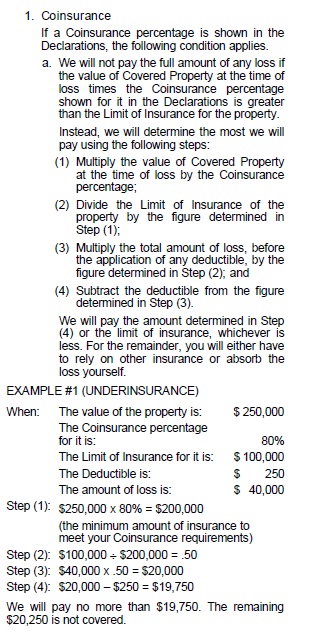
But
my insurance agent told me that I don't have a coinsurance clause and
my policy says that I have a "blanket limit." Does
this mean I am covered?
Instead of a
coinsurance provision, some policies include what is called a
"margin clause." This language can be quite deceiving
in that it often leads the insured to believe that they have a
blanket limit of insurance that can be applied to any location.
This is not the case.
A margin
clause allows the insurance company to limit the amount of coverage
available for each location by a certain percentage, despite any appearance
of a blanket limit. For example, if the policy shows an insured
value of $300,000 and it actually costs $500,000 to rebuild the
structure, the most an insurance policy with a 20% margin clause will
pay is $360,000 (i.e. 120% of $300,000) even if there is a $2,000,000
blanket limit.
A
sample margin clause is as follows:
|
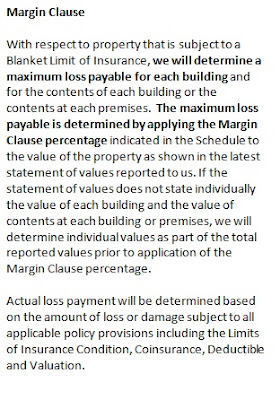
|
|
Margin Clause
|
Since
replacement costs vary depending on the construction costs and
material availability, it would be ideal to find a
property policy that does not include a coinsurance
provision or a margin clause.
But my
insurance agent promised me that the margin clause would not apply to
certain properties even though the policy seems to say otherwise.
Without citing
all kinds of cases, the policy takes precedent. Which is why we
always suggest reading your policy. Statements made by
insurance agents are not binding upon the carrier. Regardless
of what was said, the policy must be enforced in accordance with its
terms.
Protective
Safeguards
Do not be
fooled. The policy holder is not the one being protected by a
"protective safeguards provision."
A protective
safeguards provision allows the insurance company to deny coverage if
certain conditions are not satisfied at the time of loss. For
example, if the fire sprinkler system does not operate properly,
there is no coverage. If the burglar alarm system does not go
off, there is no coverage. If the smoke detectors do not work,
there is no coverage, and so on.
A common
protective safeguards provision that is included in most property
policies is included below.
|
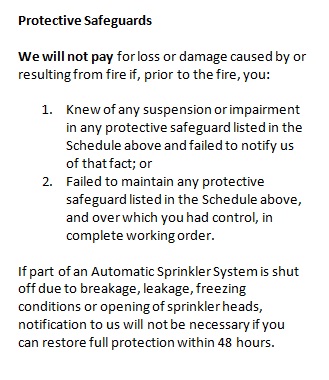
|
There
are many different types of Protective Safeguard Exclusions
|
In a case
called Burmac
Metal Finishing Co. v. West Bend Mut. Ins. Co., the
insurance company denied coverage for damage caused to the insured's
building after a natural gas explosion based on the insured's failure
to properly maintain its automatic sprinkler system as required by
the protective safeguards endorsement to the policy.
In other
cases, insurance companies have attempted to deny coverage if the
water valve for the fire suppression valve was not chained in the
full open position prior to the loss.
As with
coinsurance, a protective safeguards endorsement is a dangerous part
of your policy. In some instances, they may be unavoidable.
But avoid them if you can.
Vacancy
A vacancy
clause allow the insurance company to reduce or deny coverage if the
structure was not sufficiently occupied at the time of a loss.
Most vacancy
clauses limit coverage as follows:
|

|
|
Vacancy - click to enlarge
|
In one
instance found, the insurance carrier denied all coverage since the
rental property was vacant for more than 60 days prior to it being
destroyed by a fire. Under the terms of the policy the property
owner was not entitled to insurance benefits because the policy did
not offer coverage for properties vacant for over 60 days.
In a second
case on the subject, the insurer denied coverage for an $800,000
water damage claim from a pipe break since less than 50% of the total
square footage of the building was occupied at the time of the loss.
As with the
prior two property coverages, a vacancy clause on your policy is not
ideal. However, good luck finding an insurer nowadays who won't
put the endorsement on your policy.
The
bulk of this article first appeared in the Cambridge Property &
Casualty Report, written by Daniel P. Hale, J.D., CPCU, ARM, CIC,
AAI, LIC, AIC, AIS, API, AU.
|
|
Illinois Gaming Update
Earlier this summer the Illinois Gaming Board  began
taking applications online for gaming licenses. Prior copies of
applications have circulated around these last few years as Illinois
moved closer to adopting legalized video game gambling. Last
August, we passed along some tips to
help you prepare for the very thorough document and background check
the Illinois Gaming Board has. began
taking applications online for gaming licenses. Prior copies of
applications have circulated around these last few years as Illinois
moved closer to adopting legalized video game gambling. Last
August, we passed along some tips to
help you prepare for the very thorough document and background check
the Illinois Gaming Board has.
But now the IGB is taking applications and some
machines could begin going into circulation in a matter of
weeks. The app can be found at https://www.igb.illinois.gov/vla/.
Here are some things to keep in mind as you prepare to file your
application:
- Having
the first application in does not mean first application
approval. The IGB conducts an exhaustive review of
applicants and that process may take longer with some applicants
than others.
- Make
absolutely sure that information is accurate and truthful.
- You
cannot submit your application, withdraw it, and resubmit
it. It has to be right the first time.
- It's
recommended that applicants have another set of eyes look over
their application before submitting to verify the completeness
of the app.
We know this
is a law many of you have been watching closely and anxiously
awaiting the passage of. We'll pass along any further
information on this subject as it comes out.
|
|
Why An Older Building
Isn't Always Cheaper to Insure
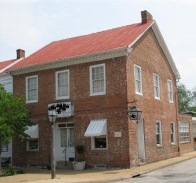
We'll occasinally get a comment to the effect of,
"my building is really old, it's not in great shape, shouldn't
it cost less to insure than a new building?" Determining
the Replacement Cost of the structure depends on it's size,
construction and characteristics. But delving deeper, why might
an older building have a higher rate with an insurance company than a
newer one?
In short, because older buildings can mean greater
risk.
One of our carriers recently tackled this in one of
their regular publications, and it seemed fitting to pass the info
along in ours.
Many older buildings are just not as good of an
insurance risk (to a carrier) as newer properties. The problems
outlined below and in combination with each other make it much more
difficult to underwrite the profitabliliy. Here's why:
1. Older buildings may not be optimal for
occupancy, and may even be obsolete. This reduces the value of
the building to the insured and discourages investment in
improvements and maintenance.
2. Older buildings often come with older wiring,
plumbing, heating, roofing and mechanicals. Even if updated,
there are still some older components that can contribute to a loss.
3. Older buildings can commonly be found in
central city areas where the crime and vandalism exposure can be
higher than suburban areas.
4. Surrounding buildings may be substandard (due
to their age and deterioration) or have vacancies. Even if they
do not directly expose the insured building, these neighborhoods may
drag down the market value of the insured property.
5. Older properties are genearally not as
profitable as newer buildings because they cannot command higher
rents. With a lower profit margin, management sometimes is not
willing to invest in maintenance and improvmeents. They either
can't do these updates or may make a conscious decision to forgo
maintenance expenses when there is limited return on investment.
6. Tenants may not be optimal and mean a greater
credit risk or character risk. Vacancies can create a financial
strain and encourage building owners to rent to less desirable
tenants.
7. Private protection, like fire and burglar
alarm systems, are usually older and less reliable.
8. The (replacement cost) values in older
buildings are inadequate more often than on newer properties.
This may cause insurance-to-value problems.
9. Older buildings are commonly remodeled at one
time or another. The oldest buildings may have undergone many
changes in occupancy and remodeling. This can be a good thing,
but it may create problems like concealed spaces, updates done by
unqualified professionals and traffic flow issues (foot traffic, in
case of emergency evacuation from the building).
|
|
Claim Reviews: Subrogation
Horrors

Subrogation is the substitution of one person in the
place of another with reference to a lawful claim, demand or right,
so that he or she who is substituted succeeds to the rights
of the other in relation to the debt or claim, and it's rights,
remedies or securities.
In insurance matters, subrogation usually involves
damage caused by one person or entity to a second person or entity.
The damaged person (or "first party") could turn the
claim into their insurer, but would have to live with the
consequences of having file a claim, such as a loss of claim-free
credits, increased rates, or, depending on their prior claim history,
possible non-renewal. If the loss was caused by another
person/entity (a "second party"), the first party would
expect the second party (or their insurer) to repair or replace their
lost or damaged property.
Things don't always resolve themselves so easily
however. If the second party is uncooperative, the first party
may have no other choice but to turn the claim in under their
insurance. Their insurer will assign an adjuster to review the
claim, ensure it is covered under their policy, and arrive at a
settlement. If possible, the first party's insurer (let's call
them Company A) may try to "subrogate" against the second
party or their insurer (Company B). Company A is standing in
for the first party, as they have incurred the cost of repairing or
replacing whatever is damaged.
Once something goes into subrogation, the first party
is usually out of the loop on further developments with the claim.
However, a claim in subrogation can still have an impact on
them. If their insurer has difficulties collecting, their file
for the claim can still be left in an "open" status.
This won't mean much to the first party unless/until they try
to move coverage.
At that time, the new carrier will ask for "loss
runs" from the past insurers. There are a number of things
on these loss runs that could lead the new insurer to issue
cancellation on the new policy: any claim that wasn't originally
reported on your application, open claims, a large past claim (even
if closed), frequent claims or even multiple claims of the same type.
So a claim that went into subrogation and has been
hanging in limbo for months or years, long after the first party's
damage was repaired or replaced, can still have lingering affects.
Which leads us to our sample claim on this subject.
The Incident
A bar owner has to escort a patron out of their building because they
were aggravating other customers. He led her outside and waited
in the doorway as the woman got into her car. As she drove away
she hit the garbage corral, spilling garbage as well as grease from
traps, then hit the side of the building causing a part of the wall
to separate from the foundation.
The insured reluctantly notified his agent of the
incident, while hoping the woman's auto insurance would cover the
damage she caused. In the meantime, the insured hired a
contractor to clean the grease spill in his parking lot and got
estimates on his building damage. Within a few days, his
insurer had started a claim file and gathered documentation of the
damage.
The bar owner's insurer shelved their claim file after
a couple of weeks, waiting for the woman's insurer to handle the
damages. A week and a half later (now nearing a month after the
incident) the woman's auto insurance wasn't covering the damages
(it's unclear on what grounds) and worse, the city was threatening to
shut the business down until repairs were made to ensure the building
was safe for the public to enter. But not just any repairs had
to be done, the existing walls had to be torn down to comply with
current code. A relatively simple repair had just
turned into a fairly substantial renovation.
The insured was out of options; he had to rely on his
insurer to cover the damage.
They did, $8900 from them and the $1000 deductible
from the insured, but the story didn't end there. The insured's
company "subrogated" against the woman for the next 28
months, recovering $2200 of the nearly $10,000 in damages she caused.
However, the woman was sent to jail on other charges, and wasn't
slated to get out for another 10 months. The company kept their file
open, so that they may decide to continue subrogation when the woman
was released.
As of today, the claim is still open, a whopping 6 and a half years
after the incident.
Conclusion
To the best of our knowledge, despite being listed as
"open" for the last 78 months this incident has never
prevented or otherwise interfered with the insured obtaining
insurance coverage. Although it easily could have, and it's
possible it still may, one day. Which would no doubt come as a
surprise to the insured who has probably long stopped caring about
the woman who hit his building.
There will presumably come a point where the insurance company
decides to wash it's hands of this matter, but with judgments in
their favor, they'll continue to pursue the woman who caused all this
damage.
There's also a valuable secondary lesson in this example about
Ordinance & Law coverage. The original estimate for repair
only was in the $3300 range. However, the city mandated that
the whole wall be torn out and replaced to comply with current code.
Since the whole wall wasn't damaged, this would have been out
of pocket expense had the insured not had an Ordinance & Law
Endorsement on his Property Policy with a $25,000 limit.
|
|
|
|
|
What Happens 473 Times an Hour?
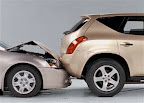
According to the Department of Transportation, traffic accidents happen
about that many times an hour across the United States. Are your
personal auto limits up to par? Or are you carrying low-limit,
cut-rate coverage?
We
offer a full-line of personal lines coverages for four home, auto,
boats, motorcycles, RVs and more. Give us a shot at your next
renewal to see how we compete.
|
|
Carrier Corner

We represent over 15
insurance carriers directly and have access to many more via brokers,
but you may only know one or two that we deal with. Each issue,
we'll highlight one of our valued partners in this space.
AmTrust
Financial is an "A" (excellent) rated carrier that
does business nationwide. They have a couple of divisions,
Technology Insurance and UBI.
We've
used Technology for years for a variety of Workers Compensation
classes. They have a wide-ranging appetite, write Work Comp on a
monoline basis and offer very competitive rates.
UBI
is a newer arm of AmTrust and targets Commercial Lines accounts in the
restaurant, auto repair, retail business & offices, commercial
property, distributing, grocery store, and manufacturing industries.
A
great feature AmTrust offers on their website is their library
of Loss Control documents. The Food Handling
Guidelines in this issue are just one example of the type of detailed
information available for free on their website.
|
|
 Our
office will be closed Monday, September 3rd in observance of Labor
Day. We'll resume normal business hours on Tuesday, September 9/4. Our
office will be closed Monday, September 3rd in observance of Labor
Day. We'll resume normal business hours on Tuesday, September 9/4.
|
|
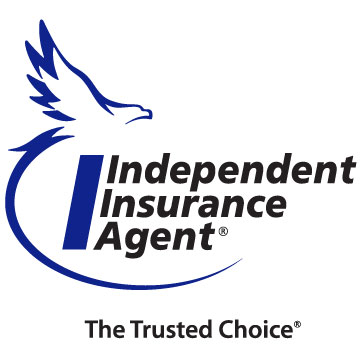 Bret
Dixon Insurance recently became a Trusted Choice Agency. Learn
more about it here. Bret
Dixon Insurance recently became a Trusted Choice Agency. Learn
more about it here.
|
|
![]()
![]()